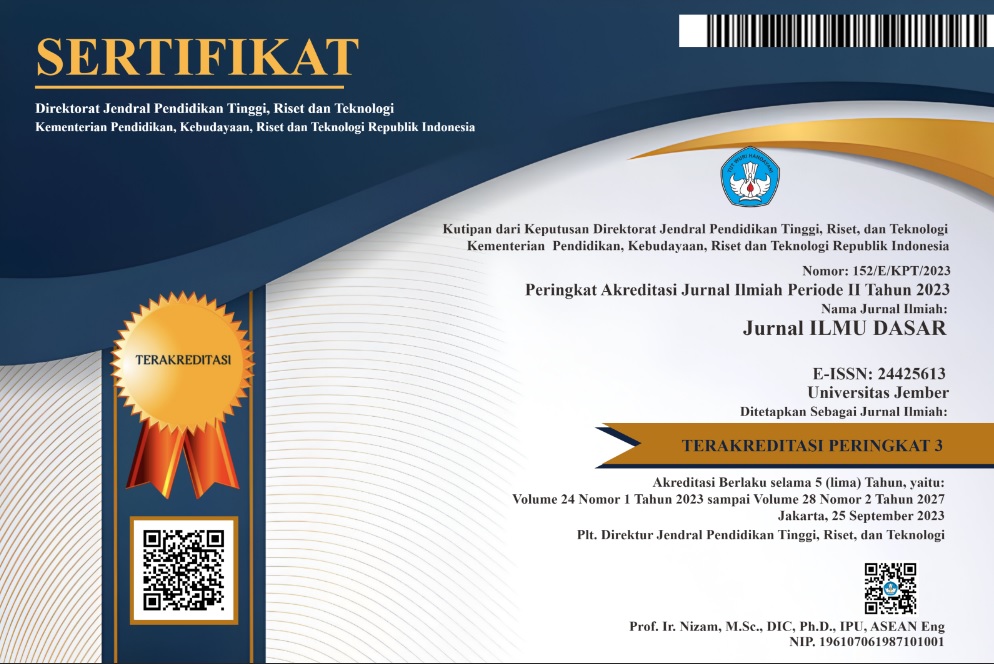Food Habit of Seluang Batu (Paracrossochilus vittatus Boulenger 1894) in Mentuka River Sekadau Districts West Kalimantan Province
DOI:
https://doi.org/10.19184/jid.v21i1.8703Abstract
Seluang batu (Paracrossochilus vittatus) is one of the Borneo endemic fish from Cyprinidae Family that live in high stream water. The aim of this study was to know the food habit and niche breadth of seluang batu in Mentuka River. This study was conducted 3 months from November 2016 to January 2017. The sampling method used in this research was purposive random sampling. Seluang batu was taken from three stations in the Mentuka River using trap nets. The fish was measured in length and weight, then dissected to find out the type of food in the stomach. Food analysis was determined using index of preponderance and the niche breadth using Smith’s index. The results showed that seluang batu in Mentuka River including herbivore because they eat microalgae, namely Synedra was main food. Nice breadth of seluang batu for peryphiton was 0.71 meanwhile plankton was 0.20. Most of peryphiton and plankton in Mentuka River are Bacillariophyceae. The Mentuka River environtment supported the life of seluang batu and their natural food, namely the temperature about 26-28 ̊C, current speed was about 1-2,6 m/s, pH was about 6,8-7,3, dissolved oxygen was about 6,1-7 mg/L and free CO2 was 3,9-5,0 mg/L.
Keywords: food habit, Paracrossochilus vittatus, periphyton, plankton.
Downloads
References
Asriyana & Yuliana. 2012. Produktivitas Perairan. Jakarta: Bumi Aksara,
Bakus GJ. 2007. Quantitative Analysis of Marine Biological Communities. California: Wiley.
Basmi J. 1999. Planktonologi: Chrysophyta-Diatom. Bogor: IPB.
Botes L. 2001. Phytoplankton Identification Catalougue. London: IMO.
Boyd CE. 1979. Water Quality Management for Fish Pond Culture, New York: Elsevier Scientific Publishing Company.
Doglov AV. 2005. Feeding and Food Consumption Bay The Barents Sea Skate. J. of Northwest Atlantic Fish Sci. 35(34).
Haas AF & Wild C. 2010. Benthic Community Composition Affects O2 Availability and Variability in a Northern Red Sea Fringing Reef. 644(1):401–405.
Hartley B. 1996. An Atlas of British Diatoms. England: Biopress Ltd.
Hinga KR. 1992. Co-occurrence of Dinoflagellate Blooms and High pH in Marine Enclosures.Mar. Ecol. Prog. Ser. 86:181–187.
Lagler FK. 1972. Freshwater Fishery Biology. USA: WM. C. Brown Company.
Natarajan AV & Jhingran. 1961. lndex of Preponderance : A Method of Grading The Food Elements In The Stomach Analysis of Fishes. Indian J. Fish. 8(1).
Nikolsky GV. 1963. The Ecology of Fishes. London: Academic Press.
Nybakken JW. 1988. Biologi Laut. Jakarta: Gramedia.
Pianka ER. 1981. Competition and Niche Theory. In R.M. May (ed.). Theoritical Ecology Principles and Application 2nd edition.Oxford: Blackwell Scientific Publ.
Rahmah Y, Kamal MM, Ernawati Y & Hukom FD. 2007. Variabilitas Ukuran Tangkap, Kepenuhan Lambung, Kebiasaan Makanan Dan Pertumbuhan Ikan Kekakapan Laut Dalam (Subfamili Etelinae) di Teluk Palabuhan Ratu, Jawa Barat. Jurnal Ilmu-ilmu Perairan dan Perikanan Indonesia. 14(2):151-157.
Siagian M. 2012. Kajian Jenis dan Kelimpahan Perififiton pada Eceng Gondok (Eichornia crassipes) di Zona Litoral Waduk Limbungan Pesisir Rumbai Riau, Jurnal Akuatika. 3(2):95-104.
Sjafei DS & Robiyani.2001. Kebiasaan Makanan dan Faktor Kondisi Ikan Kurisi (Nemipterus tumbuloides blkr.) di Perairan Teluk Labuan Banten. Jurnal lktiologi Indonesia. 1(l):7-ll.
Sulaiman ZH & Mayden RL. 2012. Cypriniformes of Borneo (Actinopterygii, Otophysi): An Extraordinary Fauna for Integrated Studies on Diversity, Systematics, Evolution, Ecology and Conservation. Zootaxa 3586:359-376.
Taraldsvik M & Myklestad S. 2010. The Effect of pH on Growth Rate, Biochemical Composition and Extracellular Carbohydrate Production of The Marine Diatom Skeletonema costatum. European Journal of Phycology.35:189-194.
Titrawani, Elvyra R & Ulfitri R. 2013.Analisis Isi Lambung Ikan Senangin (Eleutheronema tetradactylum Shaw) di Perairan Dumai. Al-Kauniyah Jurnal Biologi. 6(2):85-90.
Tjahjo DW, Purnomo K. 1998. Studi Interaksi Pemanfaatan Pakan Alami Antar Ikan Sepat (Trichogaster pectoralis), Betok (Anabas testudines), Mujair (Oreochromis mossambicus), Nila (O. Niloticus) dan Gabus (Channa striatus) di Rawa Taliwang. Bull. Penel. Perik. Indonesia. 4(3):50-59.
Welch, PS. 1980. Ecological Effect of Waste Water. Sidney: Cambridge University Press.








